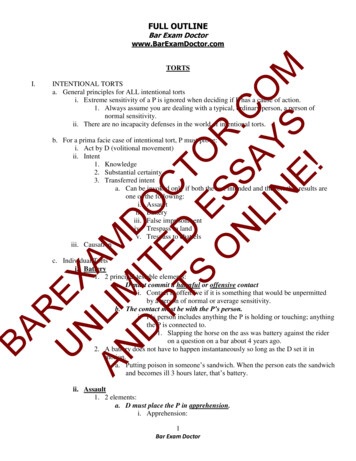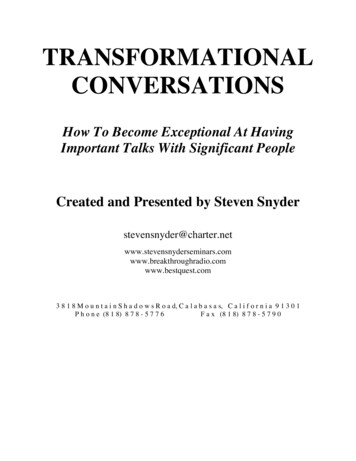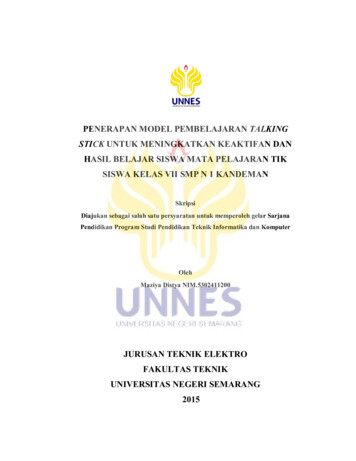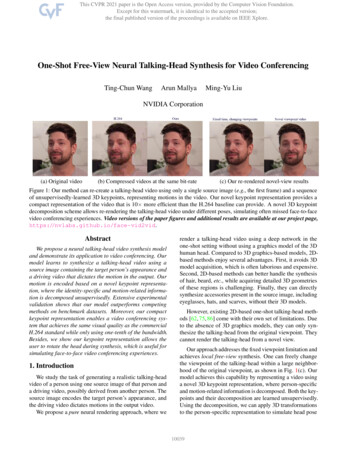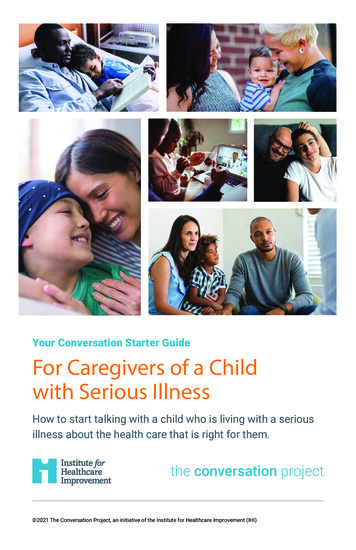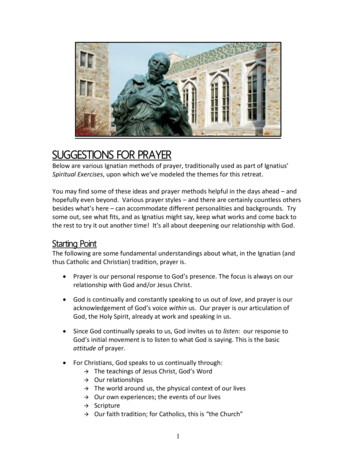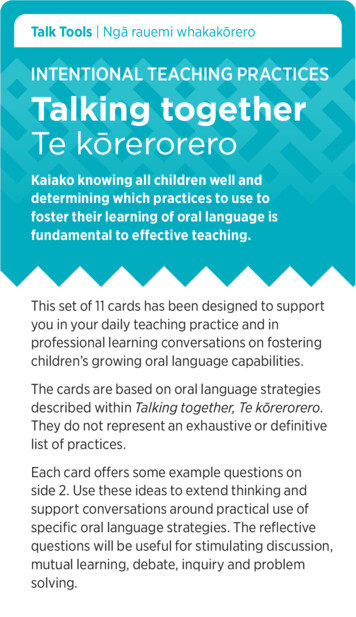
Transcription
Talk Tools Ngā rauemi whakakōreroINTENTIONAL TEACHING PRACTICESTalking togetherTe kōreroreroKaiako knowing all children well anddetermining which practices to use tofoster their learning of oral language isfundamental to effective teaching.This set of 11 cards has been designed to supportyou in your daily teaching practice and inprofessional learning conversations on fosteringchildren’s growing oral language capabilities.The cards are based on oral language strategiesdescribed within Talking together, Te kōrerorero.They do not represent an exhaustive or definitivelist of practices.Each card offers some example questions onside 2. Use these ideas to extend thinking andsupport conversations around practical use ofspecific oral language strategies. The reflectivequestions will be useful for stimulating discussion,mutual learning, debate, inquiry and problemsolving.
Talk Tools Ngā rauemi whakakōreroFor each intentional teachingstrategy card, consider:X How effectively do we use this practice?X How might we use it more frequentlyand intentionally?X What support might we need to use it?X Is there a particular child or group ofchildren who would benefit from thispractice?X How could we use it to support theirlearning?Talking together Te kōrerorero
Talk Tools Ngā rauemi whakakōreroServe andreturnCARD1Serve and return describes the back andforth interactions that take place betweenadults and tamariki in conversations.With infants and toddlers, sometimes their servewill be a gesture, glance or kick of their legs.Adults can:X start by observing the focus and interestsof tamarikiX build your response on the ways infantscommunicate, especially through tone ofvoice and facial expressionsX keep conversations going with youngchildren to explore their ideas andsupport growth in knowledge, skills,learning dispositions and workingtheories.See page 9 of Talking together Te kōrerorero
Talk Tools Ngā rauemi whakakōrero1Reflective questions:X How effectively are we supporting children’sparticipation in conversation through ouruse of the Serve and return strategy?X How can we support each other to increaseour use of Serve and return?X Are we engaging in Serve and returnpractices with all children?See page 9 of Talking together Te kōrerorero
Talk Tools Ngā rauemi whakakōreroDescriptivecommentingCARD2Adding language that describes what ishappening will help tamariki make sense oftheir environment and later express theirthoughts in new and more complex ways.SELF-TALKWhen you are alongside tamariki, talk aboutwhat you are doing as you are doing it.PARALLEL TALKYou watch the action and describe it withoutexpecting a response as if you are a broadcaster.Adults can:X follow the child’s lead and talk aboutthe things that are of interest to themat that momentX use expression in your voice, intonationand body languageX expand vocabulary and ideas in yourdescriptive comments.See pages 13-14 of Talking together Te kōrerorero
Talk Tools Ngā rauemi whakakōrero2Reflective questions:X What daily activities are working particularlywell for feeding in language alongsidetamariki? How might we build on these?X How are we effectively adjusting ourcommenting and descriptive language withinfants, toddlers and young children in ourservice?X What is one way that I could intentionallyuse the commenting strategy this week todescribe or narrate play and actions?See pages 13-14 of Talking together Te kōrerorero
Talk Tools Ngā rauemi whakakōreroInterpretingCARD3Interpreting is building on communicationwhen tamariki use sounds and actions tocommunicate: “Say it as they would if theycould”. For example, a pēpi looks at you,points out the window and says, “Ba.”The kaiako interprets, “A bird. Oh wow,a tūī landed on our tree.”Interpreting a child’s meaning is particularlyimportant with infants and toddlers when theyare communicating through actions, gesturesand sounds.Adults can:X start by being at the child’s level and carefullyobserving their interest and eye-gazeX wait for the child’s sounds/actionsX “say it as they would if they could,” usingclear language modelling; also add gestures, expressive use of your voice and facialexpression.See page 14 of Talking together Te kōrerorero
Talk Tools Ngā rauemi whakakōrero3Reflective questions:X How in tune are we with the languageattempts of all tamariki in order to effectivelyinterpret what they are communicating?X How are tamariki responding to us addingwords to their gestures (for example, in theirlooks, sounds, gestures, words)?X How could we use this strategy acrosshome languages and English?See page 14 of Talking together Te kōrerorero
Talk Tools Ngā rauemi whakakōreroExpandingvocabularyEffective ways to expand children’svocabulary (word bank) start by followingtheir interests and choosing words thatwould help them express a need or an idea.Adults can:X use a variety of words for the same thing(synonyms), when appropriateX use specific words, not general terms.For example, a tamaiti is much more likelyto know how to respond if you tell them,“Put your cup on the bench” rather than“Put it over there”X add a variety of words, such as names,actions, descriptors, question words,words for feelings and location words.See page 22 of Talking together Te kōreroreroCARD4
Talk Tools Ngā rauemi whakakōrero4Reflective questions:X What do our recent assessments tell usabout the progress of a tamaiti and groupsof tamariki in expanding their vocabulary(both understanding and expressing words)across all their languages? In what ways canwe intentionally expand the vocabulary ofall tamariki in our service?X How effective are we in supporting the useof a variety of different words throughexpansion of children’s vocabulary? What dowe need to add to our planning and practice?X Which words could be a focus area forvocabulary expansion?See page 22 of Talking together Te kōrerorero
Talk Tools Ngā rauemi whakakōrero3 Rs actionsCARD5Using elements of oral language withrepetition, rhythm, rhyme actions(non-verbal communication) is a way toweave Kaupapa Māori approaches intoa rich curriculum for all tamariki.This strategy allows kaiako to draw fromtraditional Māori ways of being, knowing anddoing. It can also be applied across all thelanguages that children are learning and using.Adults can:X strengthen the integration of te reo Māori andtikanga within the oral language environment,including use of pepeha, waiata ā-ringa,karakia, haka, pātere, pūrākau, pakiwaitaraX incorporate 3 Rs actions into teaching,modelling and language learning withineveryday activities and through playX encourage tuakana to model and supportteina joining in 3 Rs actions.See page 64 of Talking together Te kōrerorero
Talk Tools Ngā rauemi whakakōrero5Reflective questions:X How are we currently using 3 Rs actions inoral language modelling and languagelearning within everyday activities andthrough play? Which areas can bestrengthened?X Which aspects of te reo Māori and tikangaresonate with our tamariki and whānau?X What is one new aspect of te reo Māori andtikanga we can intentionally incorporate inour everyday activities and play?See page 64 of Talking together Te kōrerorero
Talk Tools Ngā rauemi whakakōreroSupportinghome languages 6CARDSupporting tamariki to develop in their homelanguage/s while they learn English providesthe foundation for them to become bilingual,biliterate, multilingual and multiliterate.Adults can:X develop relationships with whānau and haveongoing conversations about supportingchildren’s oral languageX learn some basic words and phrases in achild’s home language/s and use them indaily interactions, such as care routines, tobuild relationships with tamarikiX use music and songs from home languagesas a means to build a connection with atamaiti who does not yet speak EnglishX make the different language scripts froma child’s home language/s visible in theenvironment.See pages 16-20 of Talking together Te kōrerorero
Talk Tools Ngā rauemi whakakōrero6Reflective questions:X How are we creating opportunities in ourlearning environment for tamariki tobecome bilingual, biliterate, multilingual,and multiliterate?X How do we partner with families tosupport the home languages of tamarikiin our service?X What is one next step we can make inintentionally strengthening our partnershipwith families?See pages 16-20 of Talking together Te kōrerorero
Talk Tools Ngā rauemi whakakōreroConversationsand questionsCARD7Effective ways to foster oral language start byproviding engaging experiences and creatingshared interests. Excursions, visitors, newsongs, games, activities and books are allexamples of great conversation starters.Adults can:X feed in language by making commentsabout what you and/or the tamaitiare doingX keep the conversation going by takingturns (for a tamaiti, turns can be verbal andnon-verbal, see Serve and return)X thoughtfully use open-ended questions(eg, “What ideas do you have?”) toencourage tamariki to express theirown views.See pages 30-32 of Talking together Te kōrerorero
Talk Tools Ngā rauemi whakakōreroReflective questions:X How are we intentionally startingconversations by creating interest,engaging tamariki in thought-provokingactivities and promoting a sense ofcuriosity?X What help might I need to support myincreased use of commenting inconversations with tamariki?X How are we considering culturalperspectives in our use of questions?See pages 30-32 of Talking together Te kōrerorero7
Talk Tools Ngā rauemi whakakōreroStorytellingCARD8Storytelling is a rich practice for fosteringchildren’s language, emotional development,coping, self-concept and sense of belonging.It’s often easier for tamariki to tell storieswith the help of props.Adults can:X encourage recording of stories throughdrawing, writing and on digital devicesX make use of pausing when sharing storybooks,allowing tamariki to predict what happensnext and add to the storytellingX encourage older tamariki to extend storytellingbeyond here-and-now — ask about past eventsand explore future possibilitiesX for accomplished storytellers, introduceplanning and sequencing strategies likestoryboarding.See pages 33-36 of Talking together Te kōrerorero
Talk Tools Ngā rauemi whakakōrero8Reflective questions:X What stories do our tamariki get particularlyexcited about? What is a new way we couldinvite them to retell their stories?X How are we using pakiwaitara and pūrākauto understand the world from a Māoriperspective?X What ‘voices’ are we hearing from ourcollection of storybooks? What’s one thingwe could do to hear more stories fromfamilies and communities representedin our service?See pages 33-36 of Talking together Te kōrerorero
Talk Tools Ngā rauemi ARD9For whānau Māori, tuakana-teina relationshipsare a fundamental cultural expectation andstrength. Within these relationships an olderor more experienced child (tuakana) plays withand supports a younger or less experiencedchild (teina) in all aspects of their learning anddevelopment, including oral language.Adults can:X encourage tuakana to use language tohelp teina in play and daily activitiesX plan leadership roles for tuakana to modellanguage in a variety of contexts, eg, pepeha,karakia, waiata, storytelling, gamesX make the most of times when you, as kaiako,are in the role of teina and tamariki areteaching you aspects of their languageand culture.See pages 44-45 of Talking together Te kōrerorero
Talk Tools Ngā rauemi whakakōreroReflective questions:X How could we use our recent observationsand assessments to inform our intentionalteaching that promotes tuakana‑teinarelationships between tamariki?X How are we recognising and supportingthe leadership of tuakana in teachingoral language?X What opportunities are we providingfor fostering peer communicationthrough tuakana‑teina relationships?What currently works well?See pages 44-45 of Talking together Te kōrerorero9
Talk Tools Ngā rauemi whakakōreroWord andsound playCARD10Word and sound play with pēpi and tamarikiis important for developing phonologicalawareness (recognising and working with thesounds of spoken language) and early literacy.Being playful with language and sound isabout the sense of fun and engagementkaiako bring to their everyday interaction.Adults can:X use rhyme and rhythm through waiata,stories, poems, nursery rhymes andmade up dittiesX encourage older tamariki to makesound–letter associations and start toidentify some letters.See pages 41-42 of Talking together Te kōrerorero
Talk Tools Ngā rauemi whakakōrero10Reflective questions:X What opportunities are we providingtamariki to engage in word and sound play?X Which word and sound play activities in ourservice inspire a sense of fun and laughter?X How can we extend word and sound play inour use of te reo Māori with our tamariki?See pages 41-42 of Talking together Te kōrerorero
Talk Tools Ngā rauemi whakakōreroTalking aboutfeelingsCARD11Talking about feelings with tamariki andsupporting them to name and describefeelings helps them to understand, expressand regulate their emotions.Adults can:X talk about feelings in everyday conversationsX learn the words for different feelings inchildren’s home languages and understandthe cultural norms associated with themX consider different visual prompts andenvironmental supports that can helptamariki to express their feelings, eg,gestures, facial expressions, pictures orother objects.See pages 37-38 of Talking together Te kōrerorero
Talk Tools Ngā rauemi whakakōrero11Reflective questions:X How are we intentionally supportingall children’s progress in talking abouta wide range of emotions?X What emotions could be particularlyrelevant to explore right now?X How might we intentionally scaffoldtamariki who need support tocommunicate emotions? For example,use gestures alongside words.See pages 37-38 of Talking together Te kōrerorero
songs, games, activities and books are all examples of great conversation starters. Adults can: X feed in language by making comments about what you and/or the tamaiti are doing X keep the conversation going by taking turns (for a tamaiti, turns can be verbal and non-verbal, see Serve and return ) X thoughtfully use open-ended questions
